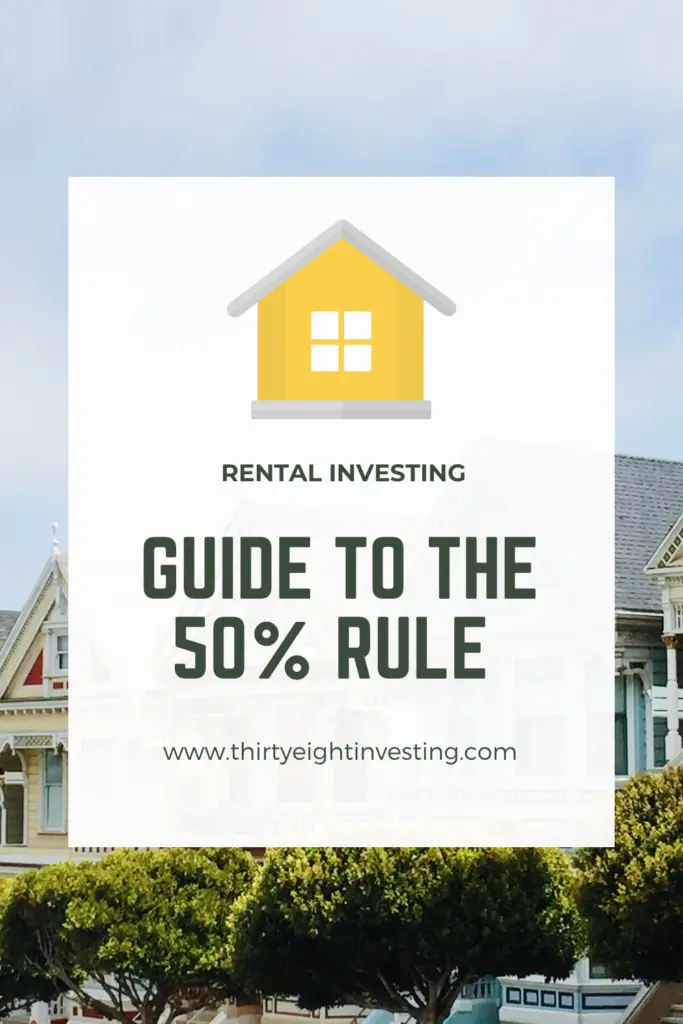Disclosure: This post may contain affiliate links that earn me a small commission, at no additional cost to you! See our disclaimer for details.
What is the 50% Rental Investing Rule?
There are many rules of thumb within rental investing. The 50% rental investing rule is a very common “rule” that helps investors to save for unexpected and expected expenses, and to effectively analyze potential cashflow of properties prior to purchase.
The 50% rental investing rule is not an absolute rule, but is a good option! I personally use it when looking at properties and regarding my own rental investments!
In short, the 50% rental investing rule states that you should set aside 50% of your rental income for your property’s operational expenses. The total expenses with the property should average to 50% of the gross rent. This includes everything from property taxes, to repairs, to maintenance. The 50% rule does not include principal and interest payments.
In this article I will fully go over what the rental investing 50% rule is, how to calculate using the 50% rule and provide you scenarios to analyze situations when looking at rental properties on your own!

Breakdown of the 50% Rental Investing Rule
It is commonly known amongst rental investors that the average fraction of operating expenses is approximately 50% of gross rent.
This is most common with multifamily properties. With single family properties, the number may be in the 40%’s but it is most common to use 50% as a safe rule.
Unfortunately this is commonly a surprise to individuals who are new to rental investing! It is easy to initially think that you’ll get to keep everything you make. However, there are a handful of expenses you’ll need to set aside. Below are a handful of expenses to consider for your rental investments.
Here are examples of operating expenses for rental properties:
- General home repairs like foundation repairs, fallen trees, roofs, etc.
- Insurance
- Property management fees
- Vacancies
- Appliance fixes
- Fixing and updating heat and air systems
- Property taxes
- Eviction costs
- Maintenance including paint, landscaping, etc.
If you have ever owned a home, you know that there are always things coming up that cost money. Some things you can fix yourself, others you cannot.
Of course you could save money by doing some home repairs, maintenance, and landscaping on your properties by yourself! However, it is imperative to consider the other expenses that come with rentals, including taxes, fees, insurance, and eviction costs that you cannot necessarily escape from or prevent!
How to Use the 50% Rule For Your Rental Properties
50% Rule Step-by-Step
This rental property investing rule is fairly simple to calculate!
As stated above, there are a lot of different expenses to save up for, but this can differ for every property you own! Some brand new properties may not need the same amount of money set aside as an older property. Nevertheless, 50% is a healthy amount.
Okay, so when learning about this rule in various books, forums, and videos over the past few years, I have come across multiple ways that the 50% rule is calculated. They are all a bit different, and you are bound to come across them all when doing your research. The first one below is the simplest! Second takes some more calculating and third is a bit more complicated.
Example 1:
The simplest way to calculate the 50% rule is by halving the estimated monthly rent. So, let’s say the estimated rent is $1,050 each month. Take that by ½, which is $525.
Monthly mortgage = $750. Gross monthly income from rent = $1,050. 50% of $1000 is $525. Therefore, you should set aside $525 for operational expenses every month.
Yet, this does not allow you to pay the $750 mortgage – you’d need an additional $250/month or else you’d be in the negative each month with the property.
This is an easy way to quickly calculate if a property would be easy to cashflow or not.
Ready to research rental deals in your area? Download DealCheck for free or get 25% their premium service with my special code VIP25OFF!
Example 2:
Let’s say you’re looking into properties but don’t have access to specific numbers as detailed above.
Let’s say you find a property at $100,000 and after analyzing your loan options, you decide that you’d set the rent at $1,050 and discover that your property’s mortgage would be approx. $700/month.
- $1050/month x 12 months = $12,600 gross income for a year.
- 50% of the gross income for the year (12,600/2)= $6,300.
- $6,300/12 = $525/month
- Rent ($1,050) – Operational Expenses ($525) – Loan payment ($700) = -$175
Yikes, negative cash flow is not a good sign. Using this property analysis would have you thinking that this property would not be a good choice for an investment.
Example 3:
What are the potential principal payments? Interest payments? Monthly rent? How about water and utilities? There are a lot of costs to consider when analyzing properties. (Remember that principal payments and interest payments do NOT go into your operational expenses for the 50% rule). Let’s take an example from one of my personal properties:
- Principal monthly payment: $121.19
- Interest monthly payment: $373.62
- Escrow monthly payment: $299.88
- Monthly mortgage (the three numbers above totaled): $794.69
- Monthly rent: $1,050
- Property management: 8%
Next, consider that the monthly mortgage above includes taxes/escrow/interest fees. Also remember that the 50% rule does not include principal and interest payments. Therefore, I’d take 50% of the remaining amount, which would be around $150 that I’d need to set aside for operational expenses.
I am then “left over” with only approximately $100 per month in positive cashflow. Note that this property wasn’t our best deal, but this is how I have calculated using this rule!
50% Rule as a Sinking Fund
Utilizing sinking funds for your rental property is a highly effective method to save for expected expenses for your properties.
Unfamiliar with sinking funds? Check out my step-by-step guide to using sinking funds in a budget!
For example, you should expect that your long-term properties will need new roofs, siding, and general maintenance to keep it livable. Ever heard of CapEx or capital expenditures?
Capital expenditures are large expected expenses that come with owning a property. That’s where a sinking fund comes into play.
By setting aside money for operational expenses through the 50% rule, you are essentially creating a sinking fund for your properties. This allows you to set aside expected expenses and helps prevent you from dipping into savings or getting into financial trouble if a big expense comes your way!
Why the 50% Rule is Important
As mentioned above, the 50% rule is not essential to follow, but is a common way to estimate cash flow from your potential rental investments.
Plus, it is far easier to calculate compared to other rules. Real estate investing is not rocket science, and thankfully this rule makes understanding costs and expenses with rentals much more understandable!
Thing is, unless you only plan on having a few properties, you run the risk of losing money if you don’t calculate properties for their potential cash flow. The 50% rental investing rule is definitely not the only “rule” out there to help you analyze a property’s success as a rental, but is one of many that you should consider!
Avoid Paying too Much for a Property
One way the 50% rental investing rule is helpful is to help you avoid investing in a property that results in a negative cash flow!
When you think about it, if you are negative by $50 a month, it may not seem like a big deal in the short term. However, if you have 50 properties that were all negative by this much each month, you’d be down $2,500 a month. Over the course of a year, this would mean $30,000 in loss!
Now, of course this is an extreme example but just goes to show the importance of making sure your potential rental investment will net positive in cash flow. Utilizing property rules like the 50% rule is one good way to avoid going in the negative each month!

